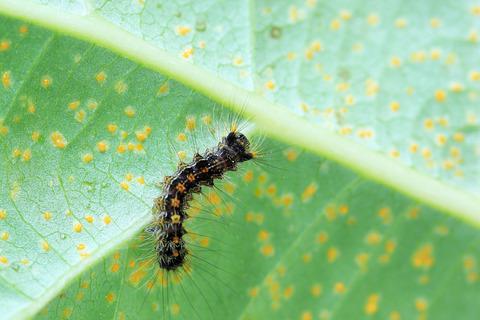当前位置:
X-MOL 学术
›
Ecol. Lett.
›
论文详情
Our official English website, www.x-mol.net, welcomes your
feedback! (Note: you will need to create a separate account there.)
Herbivory meets fungivory: insect herbivores feed on plant pathogenic fungi for their own benefit.
Ecology Letters ( IF 7.6 ) Pub Date : 2020-04-19 , DOI: 10.1111/ele.13506 Franziska Eberl 1 , Maite Fernandez de Bobadilla 1 , Michael Reichelt 1 , Almuth Hammerbacher 2 , Jonathan Gershenzon 1 , Sybille B Unsicker 1
Ecology Letters ( IF 7.6 ) Pub Date : 2020-04-19 , DOI: 10.1111/ele.13506 Franziska Eberl 1 , Maite Fernandez de Bobadilla 1 , Michael Reichelt 1 , Almuth Hammerbacher 2 , Jonathan Gershenzon 1 , Sybille B Unsicker 1
Affiliation

|
Plants are regularly colonised by fungi and bacteria, but plant‐inhabiting microbes are rarely considered in studies on plant–herbivore interactions. Here we show that young gypsy moth (Lymantria dispar ) caterpillars prefer to feed on black poplar (Populus nigra ) foliage infected by the rust fungus Melampsora larici‐populina instead of uninfected control foliage, and selectively consume fungal spores. This consumption, also observed in a related lepidopteran species, is stimulated by the sugar alcohol mannitol, found in much higher concentration in fungal tissue and infected leaves than uninfected plant foliage. Gypsy moth larvae developed more rapidly on rust‐infected leaves, which cannot be attributed to mannitol but rather to greater levels of total nitrogen, essential amino acids and B vitamins in fungal tissue and fungus‐infected leaves. Herbivore consumption of fungi and other microbes may be much more widespread than commonly believed with important consequences for the ecology and evolution of plant–herbivore interactions.
中文翻译:

食草动物遇真菌:食草动物以植物致病真菌为食。
植物通常会被真菌和细菌定居,但是在植物与草食动物之间的相互作用研究中很少考虑居住于植物的微生物。在这里,我们表明,年轻的吉普赛蛾(Lymantria dispar)毛毛虫更喜欢以被锈菌Melampsora larici-populina感染的黑杨(Populus nigra)树叶为食。而不是未感染的对照叶,并有选择地食用真菌孢子。糖醇甘露醇刺激了这种消耗,在相关的鳞翅目物种中也观察到,在真菌组织和受感染的叶子中糖醇甘露醇的浓度比未受感染的植物叶子高得多。吉普赛蛾幼虫在锈病感染的叶片上生长较快,这不能归因于甘露醇,而是真菌组织和真菌感染的叶片中总氮,必需氨基酸和B维生素含量较高。食草动物对真菌和其他微生物的消费可能比通常认为的要广泛得多,这对植物和草食动物相互作用的生态学和进化产生了重要影响。
更新日期:2020-04-19
中文翻译:

食草动物遇真菌:食草动物以植物致病真菌为食。
植物通常会被真菌和细菌定居,但是在植物与草食动物之间的相互作用研究中很少考虑居住于植物的微生物。在这里,我们表明,年轻的吉普赛蛾(Lymantria dispar)毛毛虫更喜欢以被锈菌Melampsora larici-populina感染的黑杨(Populus nigra)树叶为食。而不是未感染的对照叶,并有选择地食用真菌孢子。糖醇甘露醇刺激了这种消耗,在相关的鳞翅目物种中也观察到,在真菌组织和受感染的叶子中糖醇甘露醇的浓度比未受感染的植物叶子高得多。吉普赛蛾幼虫在锈病感染的叶片上生长较快,这不能归因于甘露醇,而是真菌组织和真菌感染的叶片中总氮,必需氨基酸和B维生素含量较高。食草动物对真菌和其他微生物的消费可能比通常认为的要广泛得多,这对植物和草食动物相互作用的生态学和进化产生了重要影响。











































 京公网安备 11010802027423号
京公网安备 11010802027423号